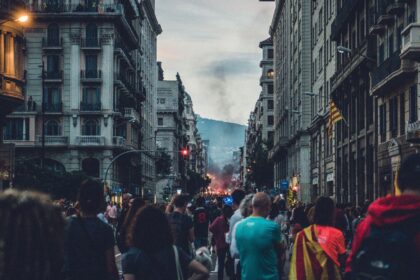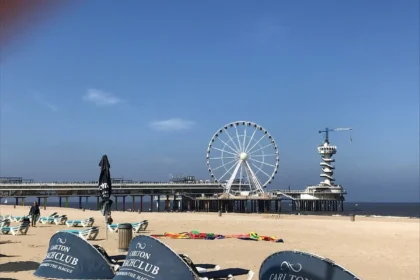
Travel has a funny way of humbling even the most confident explorers. No matter how many guidebooks you read, travel blogs you follow, or Pinterest boards you create, nothing quite prepares you for the reality of being thousands of miles from home when things go spectacularly wrong. Over the years, I’ve collected a impressive portfolio of travel disasters, each one teaching me invaluable lessons that no amount of research could have provided.
These aren’t just embarrassing stories to laugh about over dinner (though they certainly serve that purpose too). They’re hard-earned wisdom that has shaped me into a smarter, more prepared traveler. If you’re planning your next adventure, learn from my mistakes so you don’t have to make them yourself.
1. The Great Visa Oversight: When Assumptions Make You Miss Your Flight
The Mistake: I once booked a last-minute trip to Istanbul, assuming that since I was an experienced traveler, visa requirements would be straightforward. After all, I’d visited dozens of countries without issues. I showed up at the airport only to discover that my nationality required a visa that had to be obtained in advance, not at the border.
The Consequence: Not only did I miss my flight, but I also lost the non-refundable accommodation booking and had to rebook everything at much higher prices. The total cost of this oversight? Nearly $800 in additional expenses.
The Lesson: Never assume visa requirements, even for countries you think should be visa-free. Always check the official embassy website or consult with the airline directly. I now have a pre-travel checklist that includes visa verification as the very first item, and I complete this step immediately after booking flights, not the night before departure.
Pro Tip: Many countries have changed their visa policies in recent years, especially post-pandemic. What might have been true two years ago could be completely different today. When in doubt, apply for the visa anyway – it’s always better to have one you don’t need than to need one you don’t have.
2. The Currency Catastrophe: When All Your Money Becomes Useless Paper
The Mistake: During a trip to Myanmar, I exchanged a large amount of money into local currency without researching the political situation. Halfway through my trip, the military coup occurred, and suddenly ATMs stopped working, international cards were blocked, and the currency I was carrying became nearly worthless overnight.
The Consequence: I found myself in a remote area with essentially no access to money. Local vendors stopped accepting the local currency, preferring US dollars, which I had very little of. I had to rely on the kindness of other travelers and cut my trip short.
The Lesson: Always diversify your money sources when traveling. Keep cash in multiple currencies, have backup cards from different banks, and never put all your financial eggs in one basket. More importantly, stay informed about the political and economic stability of your destination, especially for longer trips.
Pro Tip: Carry emergency cash in US dollars or Euros, as these are often accepted even when local currencies fail. Keep this money separate from your main funds, and consider it insurance rather than spending money.
3. The Technology Trap: When Your Phone Dies and Takes Your Entire Trip With It
The Mistake: I became completely dependent on my smartphone for everything – maps, translations, bookings confirmations, boarding passes, and even my accommodation details. During a solo trip to rural Japan, my phone died, and I realized I had no backup plan for any of these essential functions.
The Consequence: I spent an entire day completely lost, unable to communicate with locals, and eventually had to pay for an expensive taxi to take me to what I hoped was my hotel. I couldn’t even prove I had a reservation since everything was stored digitally on my dead phone.
The Lesson: Technology is a wonderful travel companion, but it should never be your only companion. Always have physical backups of essential information: printed copies of reservations, a physical map of your destination, written addresses in the local language, and a backup power source for your devices.
Pro Tip: Create a physical “emergency packet” with printed confirmations, important phone numbers, embassy contacts, and basic phrases in the local language. Store this separately from your electronic devices.
READ ALSO: Packing Guides for Winter Travel
4. The Accommodation Nightmare: When Cheap Becomes Expensive
The Mistake: To save money on a trip to Rome, I booked the cheapest accommodation I could find without thoroughly researching the location or reading recent reviews. The photos looked decent, and the price was unbeatable – what could go wrong?
The Consequence: The “hotel” turned out to be a scam. The address led to a residential building with no hotel in sight. After hours of searching and multiple phone calls, I discovered that several other travelers had been victims of the same fake listing. I ended up paying triple the original budget for last-minute accommodation in a city with high demand.
The Lesson: When something seems too good to be true in travel, it usually is. Always book through reputable platforms, read recent reviews carefully, and verify the accommodation’s existence through multiple sources. The money you save on a suspiciously cheap booking often gets spent tenfold on emergency alternatives.
Pro Tip: Use Google Street View to virtually “visit” your accommodation before booking. If the address doesn’t match the photos or if the building looks residential when it should be commercial, investigate further before paying.
5. The Weather Wardrobe Disaster: When Nature Doesn’t Follow Your Instagram Plans
The Mistake: I planned a “winter wonderland” trip to Iceland based on stunning photos I’d seen on social media. I packed cute outfits perfect for Instagram shots but completely underestimated the actual weather conditions. My idea of “warm clothes” was a fashionable wool coat and some stylish boots.
The Consequence: I spent most of the trip cold, wet, and miserable. I couldn’t participate in many of the outdoor activities I’d planned because I wasn’t properly equipped. I ended up buying expensive gear locally, which cost more than if I’d prepared properly from home.
The Lesson: Research the actual climate conditions for your travel dates, not just the general weather patterns. Check what locals recommend wearing, and prioritize function over fashion when it comes to weather-appropriate clothing. Your Instagram photos won’t matter if you’re too cold to enjoy the experience.
Pro Tip: Check weather forecasts for your specific travel dates starting about two weeks before departure, and pack accordingly. Many destinations have microclimates that can vary dramatically from the general regional weather.
6. The Transportation Time Trap: When Everything Takes Longer Than Google Says
The Mistake: I planned a day trip from Barcelona to several small coastal towns, relying entirely on Google Maps for timing estimates. I scheduled visits to four different locations with what appeared to be comfortable time buffers between each stop.
The Consequence: Google’s estimates didn’t account for rural bus schedules, long waits between connections, or the fact that some routes only run a few times per day. I ended up seeing only one location and spent most of the day waiting at bus stops in small towns with limited amenities.
The Lesson: Always add significant buffer time to transportation estimates, especially when using public transport in rural or less touristy areas. Research actual schedules rather than relying on mapping apps, and have backup plans for when things don’t go according to schedule.
Pro Tip: When planning day trips using public transportation, start with the return journey times and work backward. This ensures you don’t get stranded in a remote location with no way back to your accommodation.
7. The Cultural Misstep: When Good Intentions Go Wrong
The Mistake: While visiting a temple in Thailand, I wanted to show respect by dressing modestly and following what I thought were appropriate customs. However, I misunderstood several cultural norms and ended up inadvertently causing offense through my actions and gestures.
The Consequence: I was politely but firmly asked to leave the temple grounds. While the locals were understanding of my foreign status, I felt embarrassed and realized I had missed an important cultural learning opportunity due to inadequate preparation.
The Lesson: Cultural research should go beyond just dress codes and basic etiquette. Understanding the deeper cultural context, religious significance, and appropriate behavior requires more thorough preparation. When in doubt, observe locals first and ask respectful questions.
Pro Tip: Connect with local cultural guides or take a brief orientation tour when visiting culturally significant sites. The small investment in local expertise can prevent major cultural missteps and enhance your understanding of the place you’re visiting.
8. The Food Safety Fiasco: When Adventure Eating Goes Too Far
The Mistake: Embracing the “eat like a local” philosophy, I threw caution to the wind during a trip to Vietnam and ate everything that looked interesting, regardless of where it came from or how it was prepared. Street food, tap water, raw vegetables – I tried it all without any consideration for food safety.
The Consequence: I spent three days of my week-long trip severely ill, unable to leave my hotel room. Not only did I miss planned activities and waste money on unused bookings, but I was also genuinely concerned about my health in a foreign healthcare system.
The Lesson: Adventurous eating and food safety aren’t mutually exclusive. You can experience authentic local cuisine while still being smart about food choices. Research common food safety practices for your destination and find the balance between adventure and caution.
Pro Tip: Look for busy food stalls with high turnover, eat cooked foods that are served hot, and be cautious with raw items, dairy products, and tap water in countries where these might be problematic. Pack basic medications for stomach issues just in case.
9. The Insurance Illusion: When You Think You’re Covered But You’re Not
The Mistake: I purchased what I thought was comprehensive travel insurance for a ski trip to the Alps. I assumed that any travel insurance would cover all activities, so I didn’t read the fine print carefully. When I injured myself skiing, I discovered that my policy specifically excluded “high-risk activities” including skiing.
The Consequence: I faced thousands of dollars in medical bills, emergency transportation costs, and had to cut my trip short with no compensation. The “comprehensive” insurance I thought I had was essentially useless for the activities I’d planned to do.
The Lesson: Travel insurance policies vary dramatically in their coverage. Always read the exclusions carefully and ensure your policy covers the specific activities you plan to participate in. Don’t assume that expensive policies are automatically better or more comprehensive.
Pro Tip: If you plan to participate in adventure activities, look for specialized travel insurance that explicitly covers these activities. It might cost more upfront, but it’s significantly cheaper than paying for emergencies out of pocket.
10. The Communication Breakdown: When Language Barriers Become Dangerous
The Mistake: While traveling solo in rural China, I relied entirely on translation apps and assumed that basic English would be sufficient for essential communications. I didn’t learn any key phrases in Mandarin or prepare for situations where technology might not work.
The Consequence: When I had a medical emergency requiring immediate attention, I couldn’t effectively communicate my symptoms or medical history to healthcare providers. The translation apps weren’t working properly, and the delay in communication could have had serious consequences for my treatment.
The Lesson: Basic language preparation isn’t just about being polite – it can be a safety issue. Learn essential phrases related to health, emergencies, and safety, and have these written down in both your language and the local language. Don’t rely solely on technology for critical communications.
Pro Tip: Create a simple medical information card in the local language that includes your allergies, medical conditions, medications, and emergency contacts. This can be a lifesaver in situations where clear communication is critical.
The Silver Lining: How Mistakes Made Me a Better Traveler
While these mistakes were frustrating, expensive, and sometimes scary at the time, they’ve collectively made me a much more competent and confident traveler. Each disaster taught me to think more comprehensively about trip planning, to prepare for multiple contingencies, and to approach travel with both excitement and realistic caution.
The most important lesson I’ve learned is that perfect trips are rare, and the ability to adapt when things go wrong is more valuable than any amount of advance planning. These experiences have taught me resilience, problem-solving skills, and cultural sensitivity that I never would have gained from smooth, incident-free travels.
Your Turn: Learning From Others’ Mistakes
Travel mistakes are inevitable, but they don’t have to be repeated. By learning from the experiences of other travelers, you can avoid the most common pitfalls and focus your energy on creating amazing memories rather than solving preventable problems.
Remember, the goal isn’t to eliminate all possibility of things going wrong – that would eliminate much of the adventure and spontaneity that makes travel exciting. The goal is to be prepared enough that when things do go wrong, you can handle them with grace, adaptability, and maybe even a sense of humor.
Every experienced traveler has a collection of disaster stories, and in time, you’ll probably have your own. The key is making sure they become great stories to tell rather than travel experiences you’d rather forget. Plan well, prepare for contingencies, stay flexible, and remember that sometimes the best travel memories come from the moments when everything goes completely sideways.
Safe travels, and may your mistakes be minor ones that make for great stories later!
In another related article, 15 Common Travel Hacking Mistakes to Avoid






